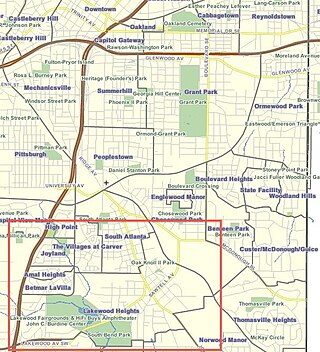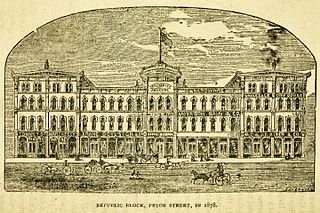
Laura Jane Addams was an American settlement activist, reformer, social worker, sociologist, public administrator, philosopher, and author. She was a leader in the history of social work and Women's suffrage. In 1889, Addams co-founded Hull House, one of America's most famous settlement houses, in Chicago, Illinois, providing extensive social services to poor, largely immigrant families. Philosophically a "radical pragmatist", she was arguably the first woman public philosopher in the United States. In the Progressive Era, when even presidents such as Theodore Roosevelt and Woodrow Wilson identified themselves as reformers and might be seen as social activists, Addams was one of the most prominent reformers.

Georgia Public Broadcasting (GPB) is a state network of PBS member television stations and NPR member radio stations serving the U.S. state of Georgia. It is operated by the Georgia Public Telecommunications Commission, an agency of the Georgia state government which holds the licenses for most of the PBS and NPR member stations licensed in the state. The broadcast signals of the nine television stations and 19 radio stations cover almost all of the state, as well as parts of Alabama, Florida, North Carolina, South Carolina and Tennessee.

Atlanta Public Schools (APS) is a school district based in Atlanta, Georgia, United States. It is run by the Atlanta Board of Education with Superintendent Dr. Bryan Johnson. The system has an active enrollment of 54,956 students, attending a total of 103 school sites: 50 elementary schools, 15 middle schools, 21 high schools, four single-gender academies and 13 charter schools. The school system also supports two alternative schools for middle and/or high school students, two community schools, and an adult learning center.

The 688 Club was a popular alternative music venue in Atlanta, Georgia, located at 688 Spring Street, near the intersection of Spring and 3rd Streets. The 688 Club opened in May 1980 and closed in November 1986. The club was operated by Steve May. The club was co-owned by Tony Evans, John Wicker, and in its final years by Mike Hendry. Cathy Hendrix served as the club's music director. During its brief lifetime, the 688 played host to hundreds of punk rock, new wave and alternative rock bands, many of whom would later become well known.

SoNo is a sub-district of downtown Atlanta, Georgia, just south of Midtown. The area was defined and named by T. Brian Glass while working on a rezoning committee with Central Atlanta Progress in 2005 in order to better establish an identity for the area and give it a hipper image. SoNo refers to the area of Downtown bounded by North Avenue on the north, Central Park Place on the east and the Downtown Connector (Interstate-75/85) on the west and south.
Briarcliff High School was a public high school opened by the DeKalb County School System in 1958 in order to relieve overcrowding at Druid Hills High School. Throughout the history of the school, Druid Hills was viewed as its "arch rival," and, with the closing of Briarcliff in 1987, the remaining students, and all the trophies, and other relics of the history of the school other than the buildings transferred to Druid Hills, where they remain today.
The Thomas A. Edison High School was an alternative public junior/senior high school in Portland, Oregon, United States, in the Portland school district.
Samuel Howard Archer High School was a high school in the northwestern part of Atlanta, Georgia, United States, which existed from 1950 through 1995, when it was merged with Harper High School to form Harper-Archer High School, which in turn closed in 2002.

Lakewood Heights is a primarily Black and rapidly gentrifying neighborhood. Many new groups such as the LGBTQIA, Asians and multi-racial individuals are relocating to the south-eastern part of the Atlanta Beltline. Formerly, this neighborhood had a Jewish working-class. It is bounded by:
College Park High School was a high school in College Park, Georgia, United States. It closed in 1988 when it was combined with Woodland High School, Russell High School and Hapeville High School to form Tri-Cities High School. The campus of College Park High is now Frank McClarin Alternative High School. The name College Park was assigned to the nearby elementary school that was formerly Beavers-Thomas Elementary. Beavers-Thomas was consolidated with S.R. Young and George Longino to make College Park Elementary.
Hapeville High School was a high school in Hapeville, Georgia, United States. The school closed in 1988 when it was combined with Woodland High School, College Park High School and Russell High School to form Tri-Cities High School. Hapeville High is now Hapeville Elementary, which brought all the elementary schools in the city into one building.

Girls' High School was one of seven schools opened in 1872 as part of the original public school system in Atlanta, Georgia, US.
The Norcross Building occupied the southwest corner of Peachtree Street and Marietta Street at Five Points in downtown Atlanta. Today the Andrew Young School of Policy Studies is located on the site. The building was owned by Jonathan Norcross, "father of Atlanta."

The Majestic Hotel was built in 1898 and located at 195 Peachtree Street NW in Atlanta, between Ellis St. and Cain St.. It was a major addition to the city's hotel capacity at its completion in the 1890s. It cost between $80,000 and $100,000 to build, and was the first brick and steel fireproof construction in the city. A 1902 guidebook describes the Majestic as one of three chief first-class hotels in the city, together with the Kimball House and the Hotel Aragon. In 1927 the hotel was razed to make way for a two-story commercial structure. The site is part of the location of today's 191 Peachtree Tower.

The Metropolitan is a condominium building at 20 Marietta Street NW at the southeast corner of Broad Street in the Five Points district of Downtown Atlanta. It was built in 1908 as the Third National Bank Building And is Atlanta's first skyscraper. It was later the Atlanta Federal Savings and Loan Building, and in the 1960s was resurfaced with dark glass. It was converted into condominiums in 1996.

Northeast Plaza is a 466,000-square-foot (43,300 m2) strip mall-style shopping center on Buford Highway in Brookhaven, Georgia just east of the Buckhead area of Atlanta. The center was built in late 1957 and renovated in 1986. In the mid-1980s it ranked as the 12th largest retail center in the Atlanta area.

The Republic Block was at the time of its completion one of the most remarkable commercial constructions in Atlanta. It faced Pryor Street between Decatur St. and Railroad Ave., now site of Georgia State University buildings. It faced the Kimball House which stood across Pryor St. to the northwest. The block was built on the initiative of William Goodnow, a manager for the Republic Insurance Company of Chicago, with partners ex-governor Joseph E. Brown, Judge O. A. Lochrane, and others Its first tenants were hardware mostly wholesale and other dealers, as well as an architect, attorney, a bank, the Atlanta Chamber of Commerce, as well as the Republic Insurance Company.

The Leyden House was one of Atlanta's most historic homes. It was located on 124 Peachtree Street NE between Cain and Ellis streets.
Murder Kroger is the nickname of a Kroger supermarket in Atlanta which has been the scene of two fatal shootings and the discovery of a corpse. It is located at 725 Ponce de Leon Avenue in Poncey–Highland and has been known as "Murder Kroger" for decades. In 1991, a 25-year-old woman named Cynthia Prioleau was shot and killed. In 2002, the malodorous corpse of a man was found inside a car. In 2015, an Alabama man, Joshua R. Richey, was shot and killed. The 2015 murder occurred after the store had been renovated and promoted by the company as "Beltline Kroger".

The M. Rich Building, also known as the M. Rich and Brothers and Company Building and the W. T. Grant Building at 82 Peachtree Street SW, Atlanta, is a landmark building significant for both architectural and commercial reasons. It housed Rich's department store from the time it was completed in 1907 until it moved into its much larger premises at Broad and Alabama streets in 1924.













